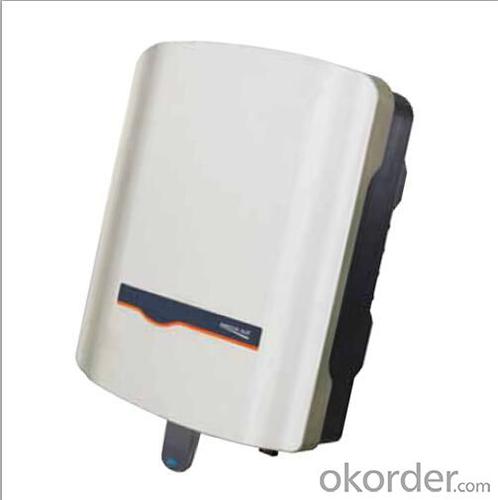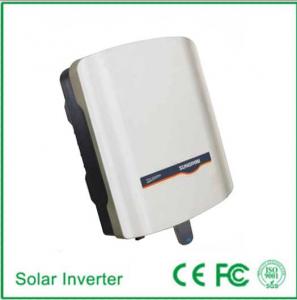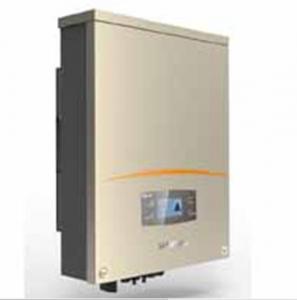Infinity Solar Inverter SG3K6TL-S
- Loading Port:
- China Main Port
- Payment Terms:
- TT or LC
- Min Order Qty:
- 500000 unit
- Supply Capability:
- 3000000 unit/month
OKorder Service Pledge
OKorder Financial Service
You Might Also Like
1. Structure of Solar Photovoltaic Grid-Connected Inverter SG3K6TL-S Description
A solar inverter, or PV inverter, or Solar converter, converts the variable direct current (DC) output of a photovoltaic (PV) solar panel into
autility frequency alternating current (AC) that can be fed into a commercial electrical grid or used by a local, off-grid electrical network.
It is acritical BOS–component in a photovoltaic system, allowing the use of ordinary AC-powered equipment. Solar inverters have
special functions adapted for use with photovoltaic arrays, including maximum power point tracking and anti-islanding protection.
Suitable for 50Hz/60Hz grid, could be used in Asia, Africa and Europe. Available for hand installation, no need for lifting machinery
assistance.
2. Main Features of the Solar Photovoltaic Grid-Connected Inverter SG3K6TL-S
• Max. input voltage 600V, compatible with different PV panel and string design
• Only 9kg, easy for handling and installation
• Max. Efficiency at 98.0%
• Ultra-quiet, suitable for residential use
• Access to home WiFi system, easy to enjoy the online monitoring
• Wireless communication design, intelligent mobile phone local and remote monitoring
• Product certification: TÜV, CE, AS4777, AS/NZS 3100, VDE AR N 4105
• Manufacturer certification: ISO 9001, ISO 14001, OHSAS 18000
3. Solar Photovoltaic Grid-Connected Inverter SG3K6TL-S Images


4. Solar Photovoltaic Grid-Connected Inverter SG3K6TL-S Specification
Input Side Data |
|
Max. PV input power | 3900W |
Max. PV input voltage | 600V |
Startup voltage | 150V |
Nominal input voltage | 345V |
MPP voltage range | 125~560V |
MPP voltage range for nominal power | 220~520V |
No. of MPPTs | 1 |
Max. number of PV strings per MPPT | 2 |
Max. PV input current | 18A |
Max. current for input connector | 20A |
Output Side Data |
|
Nominal AC output power | 3680W |
Max AC output power(PF=1) | 3680W |
Max. AC output apparent power | 3680VA |
Max. AC output current | 16.0A |
Nominal AC voltage | 230Vac (Single phase) |
AC voltage range | 180~276Vac (May vary as per corresponding country’s grid standard) |
Nominal grid frequency | 50Hz/60Hz |
Grid frequency range | 45~55Hz/55~65Hz (May vary as per corresponding country’s grid standard) |
THD | < 3 % (Nominal power) |
DC current injection | <0.5 %In |
Power factor | >0.99@default value at nominal power, (adj. 0.8 overexited~0.8 underexcited) |
Protection |
|
Anti-islanding protection | YES |
LVRT | NO |
DC reverse connection protection | YES |
AC short circuit protection | YES |
Leakage current protection | YES |
DC switch | Optional |
DC fuse | NO |
Overvoltage protection | Varistors |
System Data |
|
Max. efficiency | 98.00% |
Max. European efficiency | 97.50% |
Isolation method | Transformerless |
Ingress protection rating | IP65 |
Night power consumption | <1W |
Operating ambient temperature range | -25~60℃ (>45℃ derating) |
Allowable relative humidity range | 0~100% |
Cooling method | Natural cooling |
Max. operating altitude | 4000m (>2000m derating) |
Display | LED, LCD(optional) |
Communication | WiFi (optional) |
DC connection type | MC4 |
AC connection type | Plug and play connector |
Certification | IEC61000-6-2,IEC61000-6-3, |
AS/NZS3100,AS4777.2,AS4777.3 | |
VDE-AR-N-4105, VDE0126-1-1,CE,G83/2, C10/11,EN50438,CGC | |
Mechanical Data |
|
Dimensions (W×H×D) | 300*370*125 mm |
Mounting method | Wall bracket |
Weight | 9kg |
5. FAQ of Solar Photovoltaic Grid-Connected Inverter SG3K6TL-S
Q1. What is the difference between inverter and solar inverter?
A1. Inverter only has AC inpput, but solar inverter both connect to AC input and solar panel, it saves more power.
Q2. What is the difference between MPPT&PWM?
A2. MPPT has higher efficiency, it can track the max power point and won't waste energy.
- Q: Can a solar inverter be used with solar-powered air conditioning systems?
- Yes, a solar inverter can be used with solar-powered air conditioning systems. The solar inverter is responsible for converting the direct current (DC) generated by the solar panels into alternating current (AC) that can be used to power various electrical appliances, including air conditioning units. By connecting the solar inverter to the solar panels and the air conditioning system, the generated solar energy can be efficiently utilized to power the AC system.
- Q: Can a solar inverter be used in areas with high temperature fluctuations?
- Yes, solar inverters can typically be used in areas with high temperature fluctuations. Most modern solar inverters are designed to operate within a wide temperature range, allowing them to function properly even in environments with significant temperature variations. However, it is always important to consider the specific temperature range mentioned in the inverter's specifications to ensure optimal performance and longevity.
- Q: What is the role of a solar inverter in voltage and frequency regulation during islanding conditions?
- The role of a solar inverter in voltage and frequency regulation during islanding conditions is to ensure stability and balance in the electrical system. It actively monitors and adjusts the voltage and frequency levels to match the required standards, even when disconnected from the main power grid. This prevents overvoltage or undervoltage situations and keeps the frequency within acceptable limits, thereby maintaining a reliable and safe power supply in islanded conditions.
- Q: Can a solar inverter be used with different monitoring platforms?
- Yes, a solar inverter can be used with different monitoring platforms as long as it is compatible with the protocols and communication standards supported by those platforms.
- Q: What is the typical size and weight of a solar inverter?
- The typical size and weight of a solar inverter can vary depending on the capacity or power rating of the system. However, in general, residential solar inverters are compact and lightweight, with dimensions around 14-18 inches wide, 20-24 inches tall, and 6-8 inches deep. Their weight usually ranges between 25-50 pounds. Commercial or utility-scale solar inverters, on the other hand, can be much larger and heavier, often weighing hundreds or even thousands of pounds.
- Q: What is the maximum DC input current for a solar inverter?
- The maximum DC input current for a solar inverter can vary depending on the specific model and manufacturer. It typically ranges from 10 to 60 amps, but it is best to consult the product specifications or contact the manufacturer for the exact maximum DC input current of a particular solar inverter.
- Q: What is the role of a solar inverter in preventing islanding?
- The role of a solar inverter in preventing islanding is to constantly monitor the electrical grid and immediately disconnect from it if it detects a fault or disruption. By disconnecting from the grid, the solar inverter ensures that it does not continue to generate power and create a self-sustaining island of electricity, which could pose a safety risk for utility workers attempting to fix the fault.
- Q: What is the role of a solar inverter in a solar panel system?
- The role of a solar inverter in a solar panel system is to convert the direct current (DC) electricity generated by the solar panels into alternating current (AC) electricity that can be used to power household appliances and be fed back into the electrical grid. It also ensures that the electricity produced by the solar panels is of the correct voltage and frequency for safe and efficient use in homes and businesses.
- Q: How much maintenance is required for a solar inverter?
- Solar inverters typically require minimal maintenance. Most modern inverters are designed to be reliable and durable, requiring little to no maintenance throughout their lifespan. However, occasional cleaning of the inverter's vents and ensuring proper ventilation can help optimize its performance. Additionally, monitoring the inverter's performance and checking for any error messages or unusual behavior can help identify and address any potential issues. Overall, the maintenance required for a solar inverter is generally minimal, making it a low-maintenance component of a solar system.
- Q: How does shading affect the performance of a solar inverter?
- Shading can significantly impact the performance of a solar inverter as it reduces the amount of sunlight reaching the solar panels. When panels are partially shaded, they generate less power, which in turn affects the output of the inverter. If a significant portion of the panels are shaded, the inverter may not be able to operate optimally or may even shut down. To overcome shading issues, technologies like bypass diodes or micro-inverters can be used, which minimize the impact of shading on overall system performance.
Send your message to us
Infinity Solar Inverter SG3K6TL-S
- Loading Port:
- China Main Port
- Payment Terms:
- TT or LC
- Min Order Qty:
- 500000 unit
- Supply Capability:
- 3000000 unit/month
OKorder Service Pledge
OKorder Financial Service
Similar products
Hot products
Hot Searches
Related keywords


























